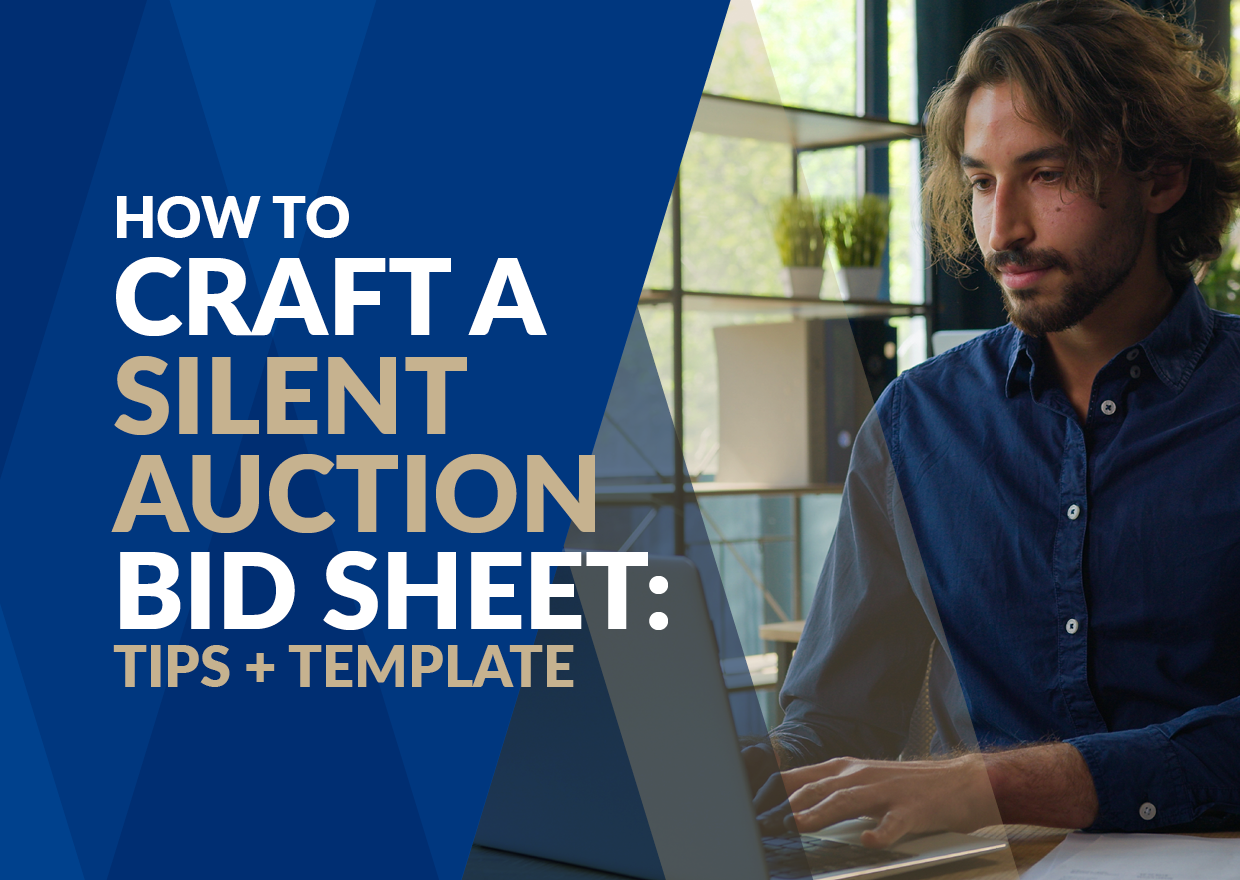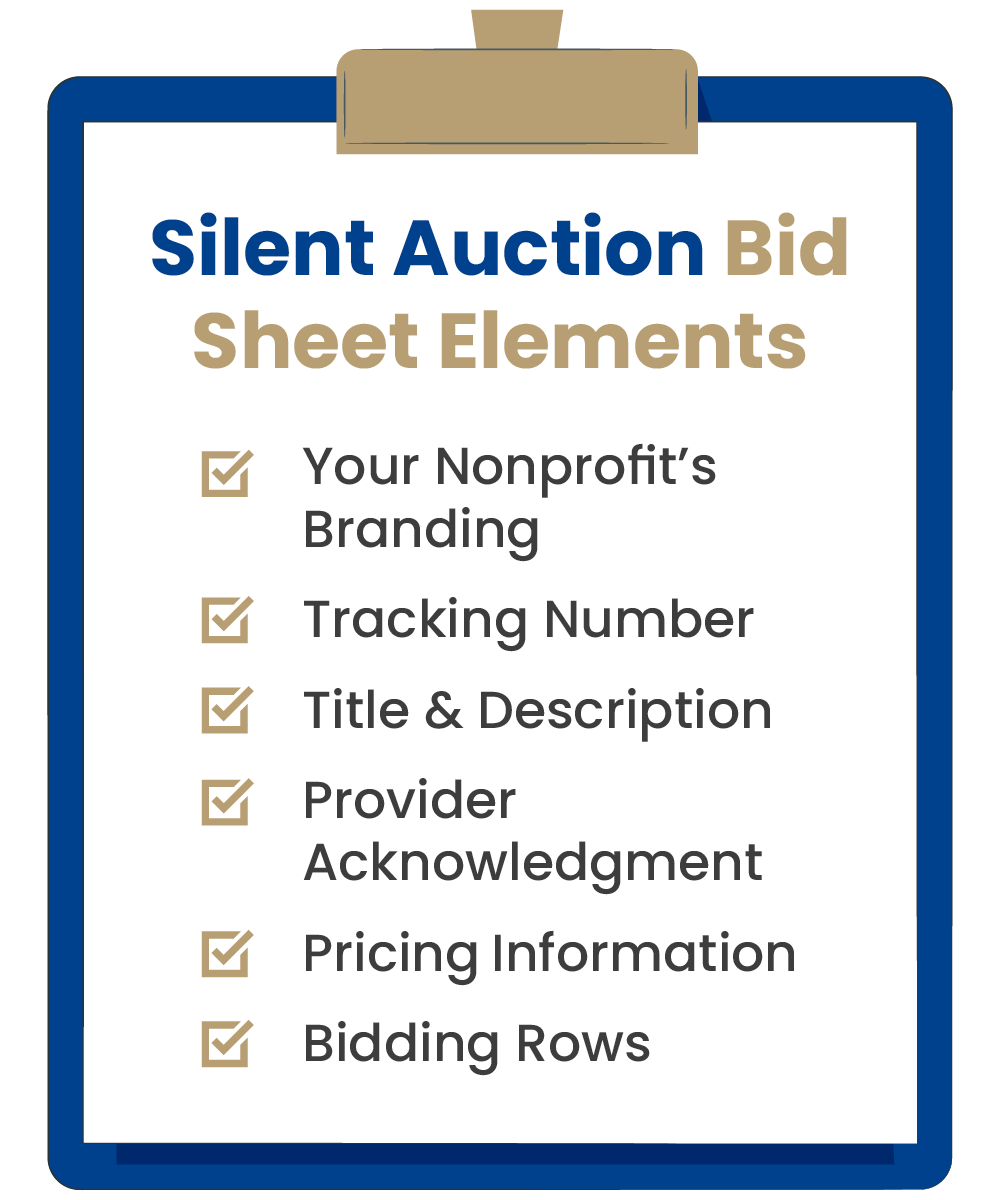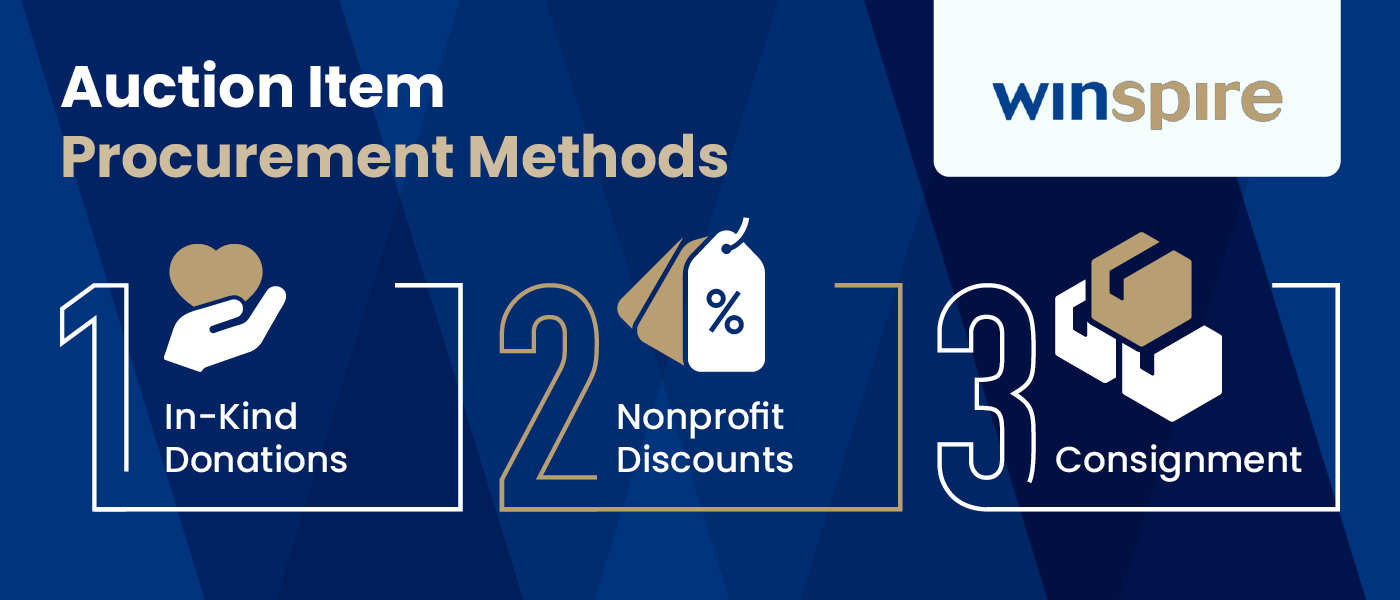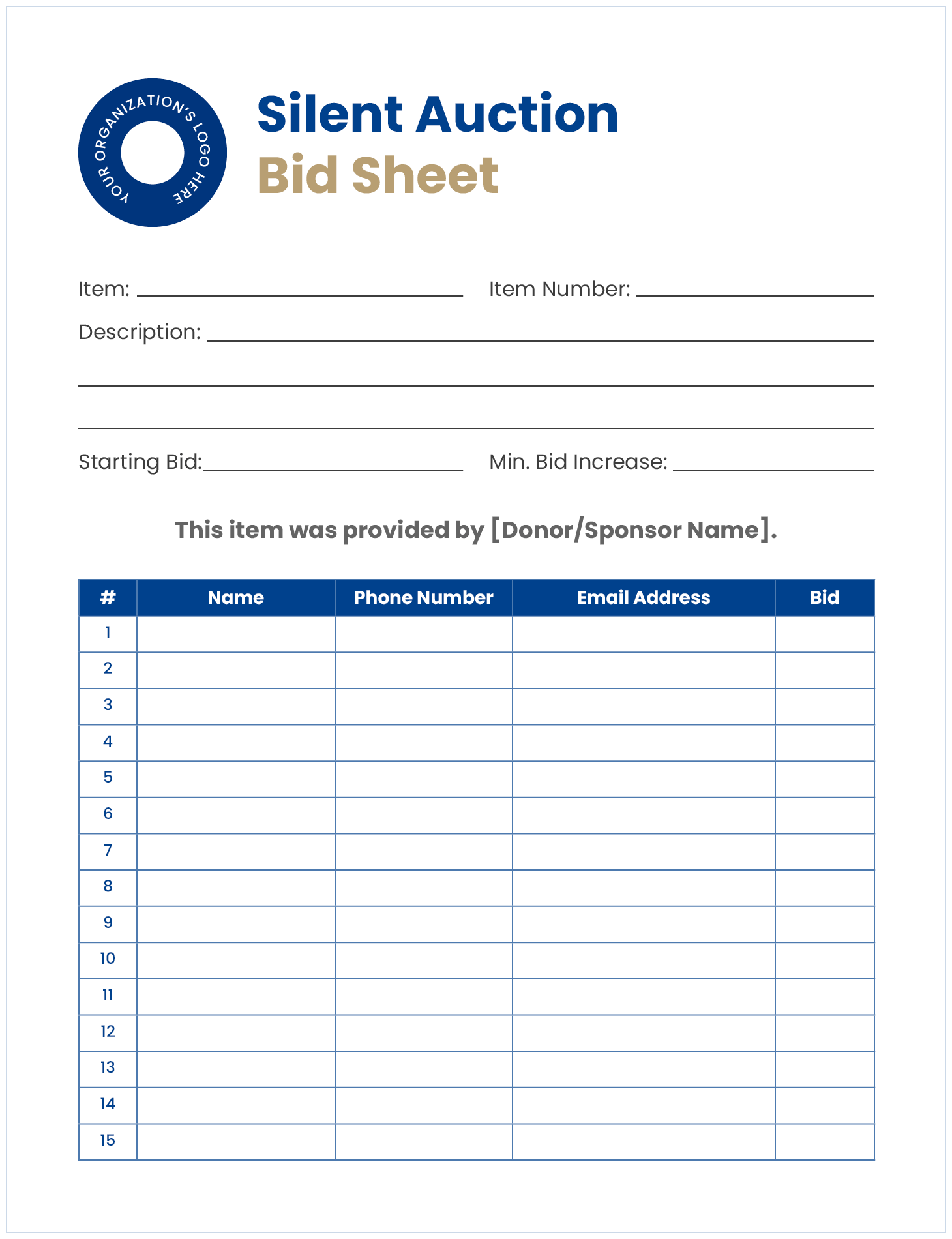When your nonprofit hosts a silent auction, the items are the star of the show. To encourage competitive bidding and hit your fundraising goal, you need to showcase your auction prizes in an appealing way. One way to accomplish this is through well-designed bid sheets.
Although bid sheets are primarily a tool to track which auction participants are vying for which items, they also help grab supporters’ attention and provide them with key information to help them decide if and how much to bid on a particular prize. In this guide, you’ll learn everything you need to know about effective silent auction bid sheet design, including:
- What is a silent auction bid sheet?
- Essential Elements of Silent Auction Bid Sheets
- Winspire’s Silent Auction Bid Sheet Template
Let’s get started by discussing the purpose of silent auction bid sheets and how they function within different event formats.
What is a silent auction bid sheet?
A silent auction bid sheet is a document used to record bids on a particular charity auction prize. Each item should have its own bid sheet where event participants write their names, contact information, and bid amounts. At the end of the auction, the highest listed bidder on each sheet wins that item.
Bid sheets also serve as the silent auction equivalent of a live auction catalog. This resource allows participants to browse through photos of the items and learn key information about each one so they can decide whether to bid when the live auction begins.
Silent auctions don’t lend themselves to catalogs because they feature many more prizes than live auctions (100 or more in many cases, as compared to 12-15 in a live auction). Additionally, the item list usually isn’t finalized far enough in advance to create and distribute a catalog. Well-designed bid sheets allow you to communicate the same details about item descriptions, sponsors, and more that an auction catalog does, but in a more manageable way for the silent auction format.
Print vs. Digital Bid Sheets
Most bid sheet tips and templates you’ll see online—including those in this guide—are geared toward physical bid sheets for in-person auctions. You’ll place these on the tables next to their respective items (or display sheets for intangible prizes). Then, participants can browse the tables, write down a bid when an item piques their interest, and quickly return to the sheet if they notice someone else outbidding them.
During virtual or hybrid auctions, you’ll use your fundraising event software to create digital bid sheets that supporters can access whether they’re attending in person or remotely. Your auction platform’s structure and features will influence how you design your bid sheets, since many come with predetermined templates and formatting requirements. For the purposes of this article, we’ll focus mostly on creating paper bid sheets, as their design is entirely up to you.
Essential Elements of Silent Auction Bid Sheets
The best bid sheets have a clean, professional-looking layout that includes all necessary information to make them as useful as possible for the silent auction format and appealing to bidders. Let’s walk through six elements you should include on every bid sheet you create.
Organization Name & Branding
Incorporating your nonprofit’s branding into event materials makes your organization more recognizable and memorable for participants, reassuring them that their contributions will support a good cause. Start by placing your organization’s name at the top of the bid sheet, then add other key brand elements like your:
- Logo
- Color scheme
- Typography
- Tagline or condensed mission statement
It’s also helpful to include a short blurb on your bid sheets about how you plan to use the funds from your silent auction so supporters know exactly what their contributions will support. For example, an animal shelter could say that “all proceeds from this silent auction will go toward essential veterinary care and medical supplies for dogs and cats in need.”
Tracking Number
Including a tracking number with each item will make your auction run more smoothly for supporters and event staff. Assign these numbers as you procure items and record them in a spreadsheet or your event software to ensure you create one bid sheet per item as you prepare for the auction.
While you can develop any system that works for your organization, many nonprofits organize tracking numbers based on item type. For example, you might use letters to denote prize categories (A for vacations, B for gift baskets, C for event tickets, etc.) and number each item in the order you received it (e.g., the first gift basket you put together becomes B01, the second is B02, and so on).
When winning bidders claim their prizes at checkout, double-check that the item, certificate, or voucher they take home matches the tracking number on the bid sheet. Then, go into your tracking system and record how much each item sold for based on its number so you can reference the data as you thank providers after the auction and plan future events.
Item Title & Description
The item title is likely the first thing participants will notice when they see a silent auction bid sheet. Once it has captured their attention, they’ll usually look for a description to confirm what they’ll win if they bid on the item.
Here are some tips to make these important details stand out on your bid sheets:
- Come up with a catchy name for each prize. Put yourself in your supporters’ shoes as you brainstorm titles. If you were attending your auction, would you be more likely to bid on a “Trip to New York City with Broadway Show Tickets” or the “Broadway Exclusive NYC Getaway”?
- List everything the winning bidder will receive. This is especially important for gift baskets and other bundled items. Supporters need to understand the prize’s true value and know exactly what they’ll win to make an informed decision about whether they’ll bid, and if so, what amount they’re willing to put down.
- Include any restrictions on the items’ use. If tickets to a professional athletic event are only valid for certain dates or a hotel stay is limited to participating locations, be transparent about these rules to ensure winning bidders can use their prizes and have a positive experience.
- Write concisely. Keep paragraphs short and use bullet points to help supporters quickly skim each description as they browse your full item selection.
Additionally, if space allows, include a small photo of the item or another relevant image for intangible prizes, such as a photo of the vacation destination the winner will travel to or the window card for a concert or musical. These visuals will also grab supporters’ attention as they browse and help ensure you match up the right items and winning bidders at checkout.
Provider Acknowledgment
When it comes to maximizing your auction revenue, how you procure items is just as important as what items you feature. To find appealing items while keeping upfront costs low, you have three general options for procurement methods:
- Soliciting in-kind donations from individual supporters and corporate sponsors, which works best for getting physical goods and gift certificates.
- Seeking out nonprofit discounts, which is usually the most effective way to secure event tickets, although you may need to contact the venue directly to negotiate them.
- Partnering with consignment auction item providers (like Winspire!) to procure vacation packages, which are rarely donated and tricky to piece together with discounts.
On each bid sheet, include a brief acknowledgment of whoever provided the prize. This can be as simple as one sentence that reads, “This item was provided by [donor/company name].”
These callouts are especially important if you received an item from a corporate sponsor—to make sponsorships mutually beneficial, nonprofits usually provide sponsors with free publicity in exchange for event support. But in any case, it’s a great way to thank the people and businesses that made your auction possible.
Pricing Information
Properly pricing your silent auction items involves finding a balance between offering prices that supporters are happy to pay and setting your organization up to meet your fundraising goals. There are four key numbers to consider as you add pricing information to each of your bid sheets:
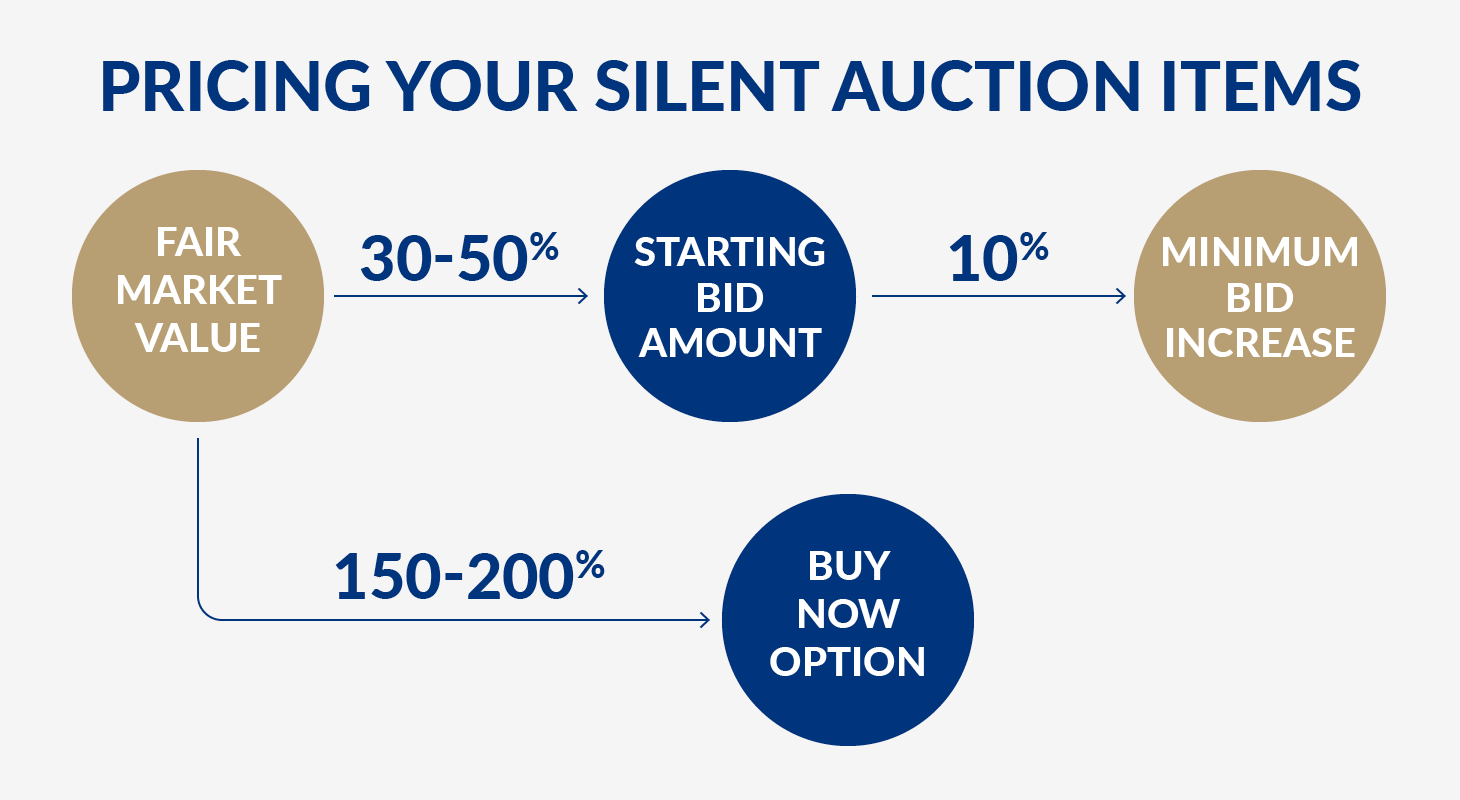
- Fair market value (FMV). This is the amount supporters would pay for an item if they purchased it on the open market, which is easier to determine in some cases than others. For donated or discounted goods, tickets, and certificates, you can simply visit online retailers’ sites to look up the item’s full price. For more unique items like artwork or VIP experiences, you may have to contact the item’s provider or do additional research to find the FMV.
- Starting bid amount. The industry standard is to set the starting bid amount for a silent auction item at 30-50% of the item’s FMV to accommodate participants’ desire to find one-of-a-kind discounts at auctions. Put commonplace items on the lower end of that spectrum and rare or unique items on the higher end, and round the amount to the nearest $10 or $100 to make calculations as easy as possible for supporters.
- Minimum bid increase. Set the minimum bid increase at approximately 10% of the starting bid amount. In most cases, this is low enough to encourage bidding wars but high enough to ensure meaningful increases that boost revenue. For more valuable items, you might need to decrease this number slightly if 10% seems like too big a hurdle for participants to want to jump over.
- “Buy Now” option. For a few of your highest-value prizes, include an option on the bid sheet for a supporter to win it outright by paying 150-200% of the FMV. It’s best not to do this for every item since bidding wars keep auction participants engaged. However, “Buy Now” options can maximize your earnings on exclusive tickets or vacation packages that some passionate supporters will want to win no matter the cost.
To see how this works in practice, let’s say your organization secures two front-row tickets to a popular concert coming up in your city. Although you negotiated a nonprofit discount on them, you figure out that their total FMV is $2,500. So, you could set the starting bid amount at $1,000 (40% of the FMV), the minimum bid increase at $100, and the “Buy Now” option at $4,000 in case you have a superfan among your supporters who will pay any amount to see that artist in concert.
Bidding Rows
Like with pricing, determining the correct number of rows for guests to enter their bids also requires striking a balance. You need to include enough rows to allow for bidding wars, but not so many that the bid sheet appears empty, making the item seem less desirable. How many rows you include will depend on the number of auction items and participants, but 12-15 is often a safe bet.
In addition to spaces for supporters to write their names and bids, include one or two columns for their contact information. Not only does this help your team track down each winning bidder at the end of the auction to ensure they claim their prizes, but it also ensures you have the information you need to send participants personalized thank-you messages after the auction.
Winspire’s Silent Auction Bid Sheet Template
While some nonprofits turn to professional graphic designers to make their silent auction bid sheets, you can also take a DIY approach to save money. To help you design your own bid sheets, our team of fundraising experts at Winspire has created a free template that you can customize for your organization.
If you’re still working on procuring silent auction items to feature on your bid sheets, Winspire can also help with that process! We offer a wide variety of bucket-list travel packages (known as Experiences) specifically designed for auctions and raffles, and we’ll provide everything you need to succeed, from destination photos for your fundraising and marketing materials to vouchers for winning bidders to book their travels through our team.
You can use any Winspire Experience in your silent auction with no risk because you only pay for what you sell at the event. Plus, every dollar you raise above the Nonprofit Cost (list price) goes directly to your organization’s mission!
Wrapping Up: Additional Silent Auction Resources
Effective silent auction bid sheet design is critical to encourage supporters to purchase your nonprofit’s auction items and help you achieve your goals. By including all of the essential elements above and using a template to create an easy-to-follow layout, you’ll develop a data collection and supporter engagement tool that you can replicate for future auctions.
For more information on silent auction preparation, check out these resources:
- How to Organize a Fundraiser Auction in 10 Simple Steps. Bid sheet creation is just one small element of planning a successful auction—explore the rest of the process in this guide.
- The Ultimate List of 150+ Silent Auction Items. Discover a wide range of items to feature on your bid sheets, from high-end goods to unique experiences.
- Silent Auction Rules: How to Ensure Your Event Runs Smoothly. Learn how to set effective silent auction rules and create bid sheets that complement them.
